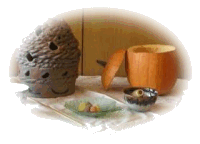THE HISTORY OF CHANOYU
 Generally speaking, the custom of tea drinking is not Japanese. Our culture
as well as our politics, economy and even our mode of living were modeled
after or adapted from those of China. This adaptation continued more or
less from ancient times to the end of the medieval age.
Generally speaking, the custom of tea drinking is not Japanese. Our culture
as well as our politics, economy and even our mode of living were modeled
after or adapted from those of China. This adaptation continued more or
less from ancient times to the end of the medieval age.
The customs of Maccha (tea-powder) started in the Sung dynasty in China. The process
of making Maccha consists of plucking the tea-leaves in May, putting them into a paper bag,
and keeping this in a big sealed jar. Then in October, at the beginning of the winter season,
the seal is opened and the tea-leaves are ground into powder. This custom was introduced
by Ei-sai from Sung China in 1191. It spread gradually and even the common people
were able to enjoy tea drinking.
Modified, that is Japanese Maccha-drinking came into existence as a synthesis
of several art forms under the influence of the Zen sect from the fourteenth
century to the sixteenth century. Also during this period some arts, the
No dance (medieval lyric drama),
flower arranging, the Kabuki play, and so on, made their first appearance on the scene.
The history of Tea Ceremony is the history of the development and perfection of artistic ceremonies using
Maccha.
Shuko, (1423-1502) a priest of low rank, came to Kyoto and felt there was something in
common between the spirit of tea ceremony and Buddhism. Through his ascetic exercises, he
made the tea ceremony more spiritual. While attending the tea parties held in many places
and associating with public entertainers, Shuko improved his knowledge and personality. He
wanted to know the tea customs of the aristocracy, that is of the Shogunate. He came to
admire No-ami, the famous artist serving the Shogun, and became his disciple staying at Dai-
tokuji temple, the head temple of the Zen sect.
Shuko criticized the tea party of his time for using only utensils made in China.
Using Japanese ceramic ware and folk art, he looked for suitable things
for the tea ceremony among everyday utensils. He was very careful in the
selection of utensils and the situation, and not only the harmony of the
tea room but also the scenery outside and the season.
It became a deep rooted idea in the heart of the Japanese nation with its
aesthetic appreciation. It is not showy beauty and merrymaking. It is the
mystery and deep joy and beauty that spring from the bottom of one's heart.
Four centuries after the introduction of the custom of tea drinking, the
real chanoyu, a Japanese art, was completed. This tea ceremony became surprisingly
popular among the aristocracy, powerful samurai and rich tradesmen. A man
who did not know chanoyu was even called a man of brutal nature.
Jo-o (1502-1555) came to Kyoto and at first wanted to be a poet. He was taught the art
of composing 31 syllable Japanese odes by Sanetaka, a noble and a classical artist. He found
his whole mind drawn to the tea ceremony, Now, to the tea ceremony that Shuko had made
by combining the Zen sect ceremony and Tocha, Jo-o added the spirit of the Japanese traditional
versification, and thus it became a higher form of art.
Rikyu (1522-1591) who served Nobunaga and Hideyoshi, rose in the world from a man of the streets in the town of Sakai and
finally he became the greatest master of chanoyu. He appears to have given
the finishing touches to chanoyu, bringing it to perfection.
Rikyu
wanted to be a tea master in his younger days, and by the time he was sixteen, he already
had become a famous tea master.
Rikyu practiced austerities because he was attracted by Shuko and wished to know the relation between the tea ceremony and the Zen sect
whose secrets Shuko and Jo-o had mastered.
He did not understand chanoyu to be only an amusement or pastime, but sought after something more spiritual in it. Thus we can understand his tendency to interpret the tea ceremony
in terms of Zen ideas.
| return |